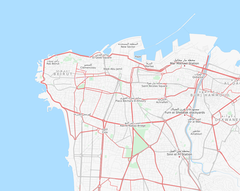Al-Omari Grand Mosque
| Al-Omari Grand Mosque | |
|---|---|
Arabic: المسجد العمري الكبير | |
 The mosque in 2008 | |
| Religion | |
| Affiliation | Sunni Islam |
| Ecclesiastical or organizational status |
|
| Status | Active |
| Location | |
| Location | Central District, Beirut |
| Country | Lebanon |
Location of the mosque in Beirut | |
| Geographic coordinates | 33°53′51″N 35°30′19″E / 33.8976°N 35.5052°E |
| Architecture | |
| Architect(s) | Youssef Haidar (2004) |
| Type | |
| Style | |
| Date established | 1291 (as an Islamic community) |
| Groundbreaking | 1113 (as a church) |
| Completed |
|
| Specifications | |
| Dome(s) | Three (estimate) |
| Minaret(s) | Two |
The Al-Omari Grand Mosque (Arabic: المسجد العمري الكبير), known as Jami' Al-Kabir, is a Sunni Islam mosque, located in the central district of Beirut, in Lebanon.
The building has been a place of worship including its original use as a Roman temple, and subsequently as a Roman church, before Beirut was conquered by Mamluk Egypt and it was converted into a mosque.
History
[edit]The Al-Omari Grand Mosque was originally a Roman temple, dedicated to the god Jupiter. The Ancient Roman influence is visible in some of the architectural elements, including the building's columns and foundations.[1]
During the Byzantine era, the building was made into a Roman basilica that featured intricate mosaics and architectural elements of the Byzantine style.[1] In the 7th century CE, the basilica was converted into a mosque.[1] During the Crusader occupation of Beirut, in the 12th century, the mosque was converted into the Church of Saint John.[1] Similar Romanesque churches with triple apses were built in Tyre and Tartus, using recuperated material such as Roman columns and capitals.[2]
In 1291, in the Ottoman era, the Mamluks captured Beirut, and under Islamic conquest the church was again converted into a mosque. It was renamed Al-Omari Mosque after the second caliph, and became known as "Jami' Al-Kabir", or the Great Mosque. Its Mamluk-style entrance and domes and minarets were added in 1350, reflecting traces of the former church's Byzantine style.[1][3]
Badly damaged during the Lebanese Civil War, the mosque's refurbishment was completed in 2004,[1] under the direction of Youssef Haidar.[4]
See also
[edit]References
[edit]- ^ a b c d e f Manasse, Jarred (September 16, 2023). "The History And Content Of The Grand Al-Omari Mosque In The City Of Beirut, Lebanon: Unveiling The Legacy Of A Great Mosque". Encounters Travel. Retrieved December 5, 2024.
- ^ Enlart, Camille (1904). "La Cathédrale Saint-Jean de Beyrouth". Société Nationale des Antiquaires de France: centenaire 1804-1904 (in French). Paris: Klincksieck. pp. 121–133.
- ^ Al-Wali, Sheikh Mohammad Taha (1973). Tarikh al-masajid wal jawami' al-sharifa fi Bayrout (in Arabic). Beirut: Dar al-Kotob.
- ^ "AlOmari Grand Mosque". Islamic Architectural Heritage. IRCICA. 2019. Retrieved December 5, 2024.
External links
[edit]![]() Media related to Al-Omari Grand Mosque at Wikimedia Commons
Media related to Al-Omari Grand Mosque at Wikimedia Commons
- 12th-century churches in Asia
- 13th-century mosques in Lebanon
- Ancient Roman temples
- Byzantine mosques
- Crusader churches
- Former churches in Lebanon
- Mamluk mosques in Lebanon
- Monuments and memorials in Lebanon
- Mosque buildings with domes in Lebanon
- Mosque buildings with minarets in Lebanon
- Mosques converted from churches in Lebanon
- Mosques in Beirut
- Romanesque church buildings
- Sunni mosques in Lebanon
- Temples of Jupiter
- Ancient churches

